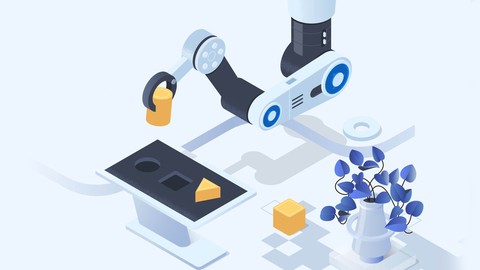
Hands-on Scikit-learn for Machine Learning
Hands-on Scikit-learn for Machine Learning, available at $34.99, has an average rating of 3.79, with 50 lectures, based on 7 reviews, and has 82 subscribers.
You will learn about Tackle real-world problems in Machine Learning through a structured process using Scikit-learn Achieve substantially more in less time and with much less code by leveraging the power and simplicity of Scikit-learn Develop a thorough understanding of core predictive analytics with regression, classification, and unsupervised learning such as clustering and PCA Create ensemble models with Random-Forest and Gradient-boosting methods and see your model performance improve drastically Build a portfolio of tools and techniques that can readily be applied to your own projects Discover the intuition behind contemporary Machine Learning models and algorithms without going into deep mathematical details Develop the ability to evaluate and improve the accuracy and performance of Machine Learning models Explore the foundations of text analytics and develop a set of tools to apply to your common text-analysis tasks This course is ideal for individuals who are If you are a software developer, machine learning engineer, or data analyst and want to use Scikit-learn for different Machine Learning and analytics tasks, this course is for you. It is particularly useful for If you are a software developer, machine learning engineer, or data analyst and want to use Scikit-learn for different Machine Learning and analytics tasks, this course is for you.
Enroll now: Hands-on Scikit-learn for Machine Learning
Summary
Title: Hands-on Scikit-learn for Machine Learning
Price: $34.99
Average Rating: 3.79
Number of Lectures: 50
Number of Published Lectures: 50
Number of Curriculum Items: 50
Number of Published Curriculum Objects: 50
Original Price: $109.99
Quality Status: approved
Status: Live
What You Will Learn
- Tackle real-world problems in Machine Learning through a structured process using Scikit-learn
- Achieve substantially more in less time and with much less code by leveraging the power and simplicity of Scikit-learn
- Develop a thorough understanding of core predictive analytics with regression, classification, and unsupervised learning such as clustering and PCA
- Create ensemble models with Random-Forest and Gradient-boosting methods and see your model performance improve drastically
- Build a portfolio of tools and techniques that can readily be applied to your own projects
- Discover the intuition behind contemporary Machine Learning models and algorithms without going into deep mathematical details
- Develop the ability to evaluate and improve the accuracy and performance of Machine Learning models
- Explore the foundations of text analytics and develop a set of tools to apply to your common text-analysis tasks
Who Should Attend
- If you are a software developer, machine learning engineer, or data analyst and want to use Scikit-learn for different Machine Learning and analytics tasks, this course is for you.
Target Audiences
- If you are a software developer, machine learning engineer, or data analyst and want to use Scikit-learn for different Machine Learning and analytics tasks, this course is for you.
Scikit-learn is arguably the most popular Python library for Machine Learning today. Thousands of Data Scientists and Machine Learning practitioners use it for day to day tasks throughout a Machine Learning project’s life cycle. Due to its popularity and coverage of a wide variety of ML models and built-in utilities, jobs for Scikit-learn are in high demand, both in industry and academia.
If you’re an aspiring machine learning engineer ready to take real-world projects head-on, Hands-on Scikit-Learn for Machine Learning will walk you through the most commonly used models, libraries, and utilities offered by Scikit-learn.
By the end of the course, you will have a set of ML problem-solving tools in the form of code modules and utility functions based on Scikit-learn in one place, instead of spread over several books and courses, which you can easily use on real-world projects and data sets.
All the code and supporting files for this course are available on Github
About the Author
Farhan Nazar Zaidi has 25 years’ experience in software architecture, big data engineering, and hands-on software development in a variety of languages and technologies. He is skilled in architecting and designing networked, distributed software systems and data analytics applications, and in designing enterprise-grade software systems.
Farhan holds an MS in Computer Science from University of Southern California, Los Angeles, USA and a BS in Electrical Engineering from University of Engineering, Lahore, Pakistan. He has worked for several Silicon-Valley companies in the past in the US as a Senior Software Engineer, and also held key positions in the software industry in Pakistan. Farhan works as consultant, solutions developer, and in-person trainer on big data engineering, microservices, advanced analytics, and Machine Learning.
Course Curriculum
Chapter 1: Getting Started with a Simple ML Model in Scikit-learn
Lecture 1: The Course Overview
Lecture 2: Course Objectives, Software Installation, and Setup
Lecture 3: Overview of Scikit-learn
Lecture 4: Scikit-learn Programming Workflow Example
Lecture 5: Applying a KNN Model on Cancer Dataset
Lecture 6: Improving the KNN Performance on Cancer Dataset
Chapter 2: Classification Models
Lecture 1: Linear and Logistic Regression
Lecture 2: Evaluating Classification Models
Lecture 3: Logistic Regression and Evaluation with Scikit-learn
Lecture 4: Decision Trees
Lecture 5: Bagging, Boosting, and Random Forests
Lecture 6: Applying Ensemble Methods with Scikit-learn
Lecture 7: Support Vector Machines
Lecture 8: Applying Support Vector Machines Classifier with Scikit-learn
Lecture 9: Multi-class Classification Example with Scikit-learn
Chapter 3: Supervised Machine Learning – Regression
Lecture 1: Downloading and Inspecting the Dataset
Lecture 2: Handling Categorical Features and Missing Values
Lecture 3: Creating Train and Test Sets and Finding Correlation
Lecture 4: Feature Scaling, Evaluating Regression Models, and Applying Linear Regression
Lecture 5: Regularization Techniques for Regression Analysis
Lecture 6: Applying Random Forest for Regression Analysis
Lecture 7: Multi-Layer Perceptron, Neural Networks, and Applying MLP with Scikit-learn
Chapter 4: Unsupervised Learning —Dimensionality Reduction
Lecture 1: Principle Component Analysis
Lecture 2: Applying PCA with Scikit-learn for Feature Reduction
Lecture 3: Applying PCA for a Regression Problem on a Large Dataset
Lecture 4: Nonlinear Methods of Feature Extraction – t-SNE and Isomap
Lecture 5: Applying Dimensionality Reduction Techniques to Images
Chapter 5: Unsupervised Learning – Clustering
Lecture 1: Introduction to Clustering and k-means Clustering
Lecture 2: Applying k-means with Scikit-learn
Lecture 3: Agglomerative Clustering
Lecture 4: DBSCAN Clustering Algorithm
Lecture 5: Applying DBSCAN with Scikit-learn
Chapter 6: Improving ML Model Performance
Lecture 1: Handling Missing Values and Data Cleaning
Lecture 2: Handling Missing Values and Scaling Numerical Features
Lecture 3: Handling Outliers and Removing Distribution Skew
Lecture 4: Handling Outliers and Removing Distribution Skew (Continued)
Lecture 5: Deriving Additional Features
Lecture 6: Evaluating Different Models and Cross- Validation
Lecture 7: Model Selection Strategies
Lecture 8: Feature Engineering for Classification
Lecture 9: Model Selection Strategies for Credit Risk Assessment
Chapter 7: Creating Pipelines and Advanced Model Selection
Lecture 1: Creating Processing Pipelines with Scikit-learn
Lecture 2: Using Pipelines on Our Credit Risk Assessment Dataset
Lecture 3: Advanced Model Selection Techniques
Lecture 4: Practicing Pipelines with a Time-Series Dataset
Chapter 8: Handling Text Data with Scikit-learn
Lecture 1: Bag-of-Words Model and Sentiment Analysis
Lecture 2: Using Stop-Words and TF-IDF for Sentiment Analysis
Lecture 3: Using N-Grams to Improve Model Performance for Sentiment Analysis
Lecture 4: Using Stemming and Lemmatization for Sentiment Analysis
Lecture 5: Topic Modeling with TruncatedSVD and Latent Dirichlet Allocation
Instructors
-
Packt Publishing
Tech Knowledge in Motion
Rating Distribution
- 1 stars: 1 votes
- 2 stars: 0 votes
- 3 stars: 2 votes
- 4 stars: 2 votes
- 5 stars: 2 votes
Frequently Asked Questions
How long do I have access to the course materials?
You can view and review the lecture materials indefinitely, like an on-demand channel.
Can I take my courses with me wherever I go?
Definitely! If you have an internet connection, courses on Udemy are available on any device at any time. If you don’t have an internet connection, some instructors also let their students download course lectures. That’s up to the instructor though, so make sure you get on their good side!
You may also like
- Best Cybersecurity Fundamentals Courses to Learn in December 2024
- Best Smart Home Technology Courses to Learn in December 2024
- Best Holistic Health Courses to Learn in December 2024
- Best Interior Design Courses to Learn in December 2024
- Best Nutrition And Diet Planning Courses to Learn in December 2024
- Best Yoga Instruction Courses to Learn in December 2024
- Best Stress Management Courses to Learn in December 2024
- Best Mindfulness Meditation Courses to Learn in December 2024
- Best Life Coaching Courses to Learn in December 2024
- Best Career Development Courses to Learn in December 2024
- Best Relationship Building Courses to Learn in December 2024
- Best Parenting Skills Courses to Learn in December 2024
- Best Home Improvement Courses to Learn in December 2024
- Best Gardening Courses to Learn in December 2024
- Best Sewing And Knitting Courses to Learn in December 2024
- Best Writing Courses Courses to Learn in December 2024
- Best Storytelling Courses to Learn in December 2024
- Best Creativity Workshops Courses to Learn in December 2024
- Best Resilience Training Courses to Learn in December 2024
- Best Emotional Intelligence Courses to Learn in December 2024





















